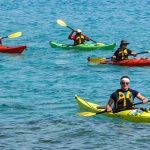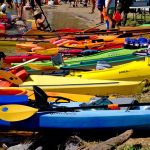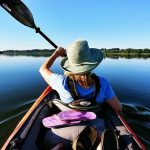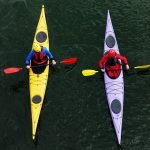If you want to have the best possible experience, you should know about the rivers or lakes you’ll be paddling, the type of paddling you’re interested in, and your own level of experience.
Getting the right boat will make your work easier and give you some great memories. The main difference between ocean yaks and lake yaks is their size; ocean yaks are much larger than lake yaks.
Ocean yaks also have a wider range of equipment and storage options, and they are more energy-efficient and durable.
The design of a kayak will differ depending on whether it is sit-on-top or sit-inside, and each one is made specifically for a certain activity. Yaks that are found in lakes are commonly used for recreational kayaking and are best suited for waters that are either calm or have very slowmoving currents.
They are great for people who are just starting out with kayak fishing or for those who want to spend some time alone in nature. Its uniqueness is easy maneuverability and stability.
While ocean kayaking is suitable for advanced level paddlers, it is sometimes referred to as touring or sea kayaking. The ocean yaks are perfect for those who want to move quickly on the water and paddle for a long time in the ocean or rough waters.
This yak is more distinguished than others because it is twelve feet long, it is narrow, and it has a smaller cockpit. However, be ready to dig deep into your pockets.
What Is The Main Difference Between Ocean Kayak And Lake Kayak?
The main difference between the two types of kayaks includes their design, length, width, equipment, storage, durability, and energy. If you’re looking for an entry-level kayak for lake or recreation use, pocket-friendly options that will still give you a good experience are the way to go.
This yak is perfect for relaxing and having fun while taking photos.
Most kayaks are sit-on-top models, which makes it easy to get in and out of the water. They are sturdy and you can easily move them around.
If you’re interested in kayak fishing, Lake Kayak is a great option. Many of their kayaks come with fishing rod holders to make your life easier.
Yaks that are meant to paddle over large lakes or open oceans are perfect for skilled paddlers. The design of these boats helps them move quickly and efficiently through water, while also requiring less effort from the kayaker.
Let’s discuss their main differences in detail below:
Length
There is a big difference in the size of these two types of yaks; the lake yaks are much smaller, only 8 to 14 feet long. Oceans are wider with a length measuring from 12 feet to 24 feet. The specific length of the yak’s fur has a purpose.
The short range of lake boats is useful for navigating around obstacles. The ability to maneuver is very important, especially if you need to paddle through tight bends in a shallow waterway.
The ocean kayaks have more time and space to avoid obstacles than other types of kayaks. The longer length of racing kayaks enhances performance in open water by increasing speed and improving tracking ability.
Width
Width is also an important factor to consider when choosing a yak. Ocean/touring kayaks have a narrower width than their counterparts’ lake yaks.
The shape of the hull on a yak tends to be angular because of the yak’s width, as opposed to the rounded shape of a recreational boat.
The narrow width of ocean yaks helps them to cut through the waves and keeps them on a straight line. This kind of boat is not suitable for beginners as they can feel very tippy while paddling. It is however, suitable for experienced kayakers as it can be quite challenging.
Lake Yak’s wider width helps it ride on top of the waves rather than cutting through them. Although they are not able to move very quickly, kayaks are very stable and you can stop paddling for a short period of time without tipping over.
Equipment
The equipment available in these two yaks differs. One key factor that sets these phones apart is the fact that they have different features. For example, some phones have a better camera than others. Unlike recreational models, ocean kayaks typically have more gears attached to them.
Since they are longer, touring kayaks have a front hatch so you can access items stored in front of the footpegs.
The yaks are also equipped with removable skegs and rudders. A skeg is a part of a boat’s hull that is normally lowered from the stern and helps improve the boat’s tracking. This in turn makes the boat less maneuverable.
While it is easy to paddle in a straight line on a large body of water, it does not present a challenge. A rudder is similar to a skeg, but it is controlled by ropes that are attached to the foot pedals. To turn your boat without paddling, you must press the rudder on one side.
While yaks used for recreation have few gear options, those that come with fishing rod holders or other similar additions can help kayakers meet their needs. One more reason that ocean yaks have more gears is because of the high risk of exposure to waves and currents in far-end open waters.
These obstacles could tip the boat over, and you need to have the right tools to save yourself.
Storage
Ocean kayaks offer more secure storage space than any other model. The kayak is less stable than other boats because it is easy to tip over. This is a problem in rough waters where kayakers need to have more emergency gear with them.
The hatch is locked so the tools can’t be lost. Sea fishers need a lot of storage space for their gear.
Even though lake yaks have storage space, it’s not that large. Paddlers can store their coolers or tackle bag, but there may not be enough space for everything. Recreational yaks can be used to travel along rivers and lakes while enjoying the natural surroundings.
Durability
No company wants to admit that their yaks aren’t durable. The material used and the building process will determine how long the structure will last. So be keen while making the purchase.
Most touring kayaks are built to be tough and durable, to withstand the harsh conditions they often face while out on open water. They are generally heavier, making their overall price high.
The cost of a yak is mainly determined by the type of material used. Since lake yaks are more affordable, it means the material used is often not as tough as the one used to make ocean boats.
Overall condition
What the kayak looks like is important because it will be one of the first things people see. Look for fading caused by too much sun exposure, and push down hard on the bottom of the hull.
It shouldn’t be soft. Inspect the top and bottom of the kayak for deep scratches (deeper than 3 mm or 1/8th of an inch), visible wear and tear, or damage that would make the kayak paddle less efficiently.
Most recreational kayaks are made from plastic, which is extremely durable and able to withstand a lot of abuse. The damage doesn’t need to be repaired as long as the kayak’s shape is still intact.
Outfitting
I.e., outfitting is the part of the kayak that the paddler sits in and uses to control the kayak. This includes the seat, back support, thigh rests, and footrests. Check each part of the boat to make sure it works well and is comfortable.
The best way to do this is by sitting in the boat and paddling it.
What you wear while you’re sailing is often a matter of personal preference; there’s no one outfit that will work for everyone. Make sure the seat is supportive and padded, the footrests are in good condition and can be operated easily, and the back support is secure.
All of these factors are important for being able to paddle effectively and comfortably.
One of the negative aspects of a kayak that is priced cheaply is that the gear that comes with it is not of high quality. If you’re planning on doing more serious paddling, it’s worth taking a close look and investing in a more expensive kayak.
If you know how to work with your hands, you can easily modify your equipment with some glue, foam, and time; consider any upgrades you could make to save some money and get a custom fit.
The main difference between fishing kayaks and regular kayaks is the accessories. Things like rod holders and live wells are essential for kayak fishing, so make sure to check for them before you buy.
On the water
The best way to understand the comfort and performance of a kayak is to try it out before you buy it. Arrange a meeting place with the seller near a body of water, so you can take a few moments to test the kayak out.
Please come with your paddle and dressed in clothing that you don’t mind getting wet.
Make a deal
Used kayaks are typically half their original price. The pandemic has caused a shortage of boats, and the demand for outdoor equipment has increased, making it more expensive.
However, you can use this information to your advantage when negotiating a price.
Add some accessories
See if the seller is open to giving a paddle, sprayskirt, or PFD along with the purchase (double-check that it’s in good condition, fits well, and is approved by the Coast Guard for where you’ll be using it).
If you have your own kayaking gear, you may be able to save a few dollars by not opting for a package deal.
types of kayaks
Recreational kayaks vs sea kayaks
Sea kayaks are designed for more experienced paddlers who are comfortable in more challenging environments. They are usually longer and narrower (starting at 14 feet in length and under 25 inches wide) and more efficient for paddling longer distances.
In general, sea kayaks are better suited than recreational kayaks for use in rough water and inclement weather, provided the paddler has the appropriate skills and experience.
Whilst sea kayaks have decks and cockpits specifically designed to be used with a sprayskirt to protect the user from the elements, this is not always necessary and many people choose not to use them.
One of the most important features of sea kayaks are the watertight bulkheads, which allow groups of trained paddlers to quickly respond to capsizes in open water.
Sea kayaks are more expensive than recreational kayaks and are designed for specific applications, such as kayak camping, rough water paddling, or traditional Greenland-style kayaking.
If you want to develop your skills and explore coastlines, a sea kayak would be a good option.
Ocean kayaks vs lake kayaks
When first getting into kayaking, many people use the terms “ocean kayak” and “lake kayak” interchangeably. However, these terms are not quite accurate and are rarely used by experienced kayakers.
A kayak meant for recreation can be used in oceans, lakes, or rivers as long as the water is calm and there are no strong currents. One possible reason why there is confusion between the terms ‘sit-in kayak’ and ‘sit-on-top kayak’ is that one of the first recreational kayaks was made by Ocean Kayak, which is still in production today.
Lake kayaks are not designed for large lakes as the conditions are too difficult. It’s better to use the term “sea kayak” for kayaks that are advanced and suitable for open water conditions and “recreational kayak” for kayaks that are meant for casual use in sheltered environments.




